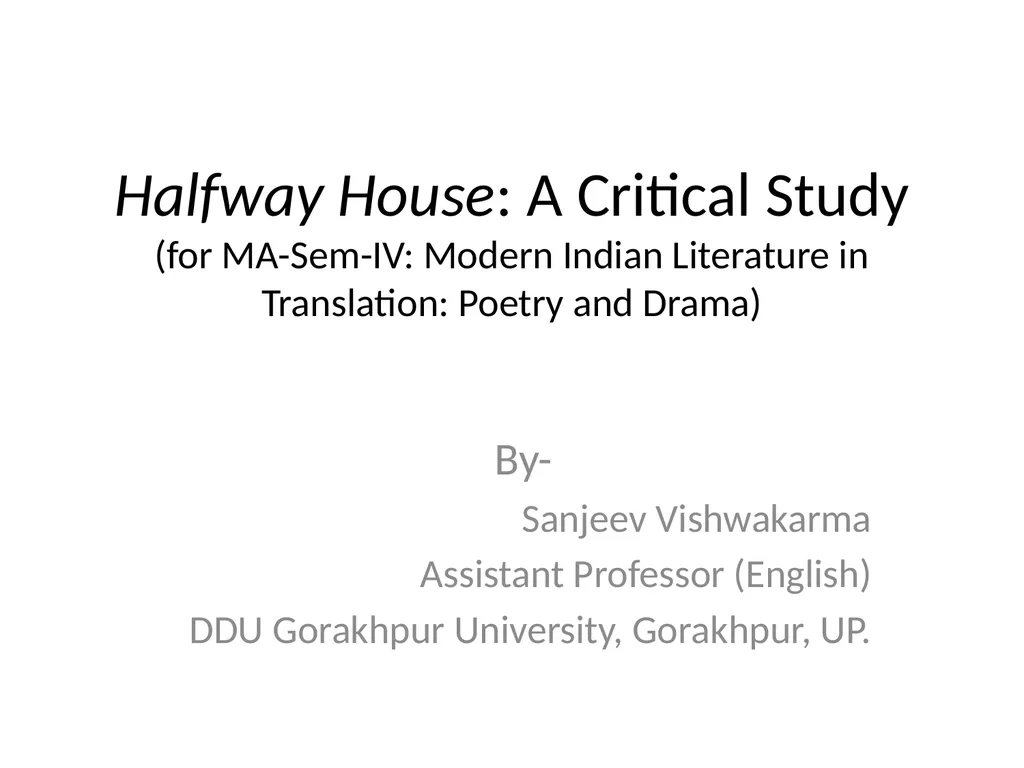Halfway House: A Critical Study (for MA-Sem-IV:
Author : trish-goza | Published Date : 2025-05-10
Description: Halfway House A Critical Study for MASemIV Modern Indian Literature in Translation Poetry and Drama By Sanjeev Vishwakarma Assistant Professor English DDU Gorakhpur University Gorakhpur UP PostIndependence Indian Drama After
Presentation Embed Code
Download Presentation
Download
Presentation The PPT/PDF document
"Halfway House: A Critical Study (for MA-Sem-IV:" is the property of its rightful owner.
Permission is granted to download and print the materials on this website for personal, non-commercial use only,
and to display it on your personal computer provided you do not modify the materials and that you retain all
copyright notices contained in the materials. By downloading content from our website, you accept the terms of
this agreement.
Transcript:Halfway House: A Critical Study (for MA-Sem-IV::
Halfway House: A Critical Study (for MA-Sem-IV: Modern Indian Literature in Translation: Poetry and Drama) By- Sanjeev Vishwakarma Assistant Professor (English) DDU Gorakhpur University, Gorakhpur, UP. Post-Independence Indian Drama After the legalisation of copyright issues in the last decade of the nineteenth century, publication and circulation of books in different countries became quite convenient for publishers. The undisputed circulation of books in foreign markets led revolutionary changes in the literary movements and activities all over the world. Indian Drama was also influenced by foreign (Western) playwrights, thoughts, techniques and stage settings owing to the availability of plays of Henrik Ibsen, G B Shaw, Bertolt Brecht, Samuel Becket and others. Though problem plays were being written in Europe in the later decades of the nineteenth and early decades of the twentieth century, they were written in India after Independence as the nationalist movement of India in the first half of the 20th century kept Indian drama under its influence in the leadership of Jayashankar Prasad and Maithilisharan Gupt who were re-establishing and reviving the past values of Indian culture, tradition and history. Post-Independence Indian Drama The Western development in dramatic techniques also influenced Indian theatre at large. On the one hand the traditional Parsi theatre turned into the Bollywood following similar stage settings of the proscenium theatre, Stanislavsky and Brechet had greater impact on theatre techniques and stage settings. The revolutionary Russian influence on Indian drama became a challenge to the current government in Bengal and Eastern India after the formation of IPTA (Indian People's Theatre Association), the British liberal forms and techniques in drama were promoted through the foundation of NSD (National School of Drama) to counter the growing influence of IPTA. In the process of modernization, westernization and revolutionization, Indian drama lost its Sanskrit influence and became totally cut off from traditional theatre techniques. Jayashankar Prasad tried to keep Indian theatre closer to Sanskrit tradition but the Post-Prasad era of northern-Indian drama was technically a new form. Halfway House: Techniques and Stage Settings The play has been written in two Acts of almost similar length. Mohan Rakesh was an expert in experimenting with techniques and styles in his plays. Looking closely at the formal aspects of Halfway House, one can find that the play is in , a little bit, similar tradition of the plays of Badal Sircar, while the theme is concerned with a capitalist system of society














